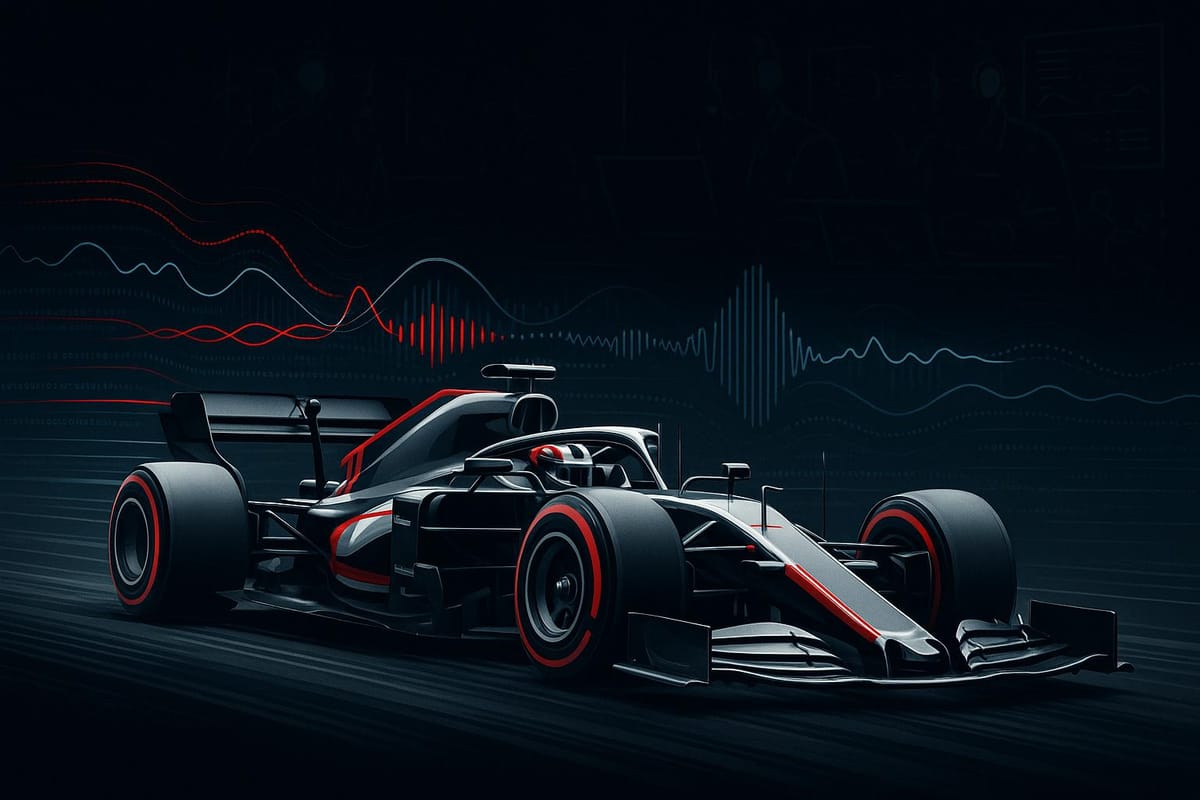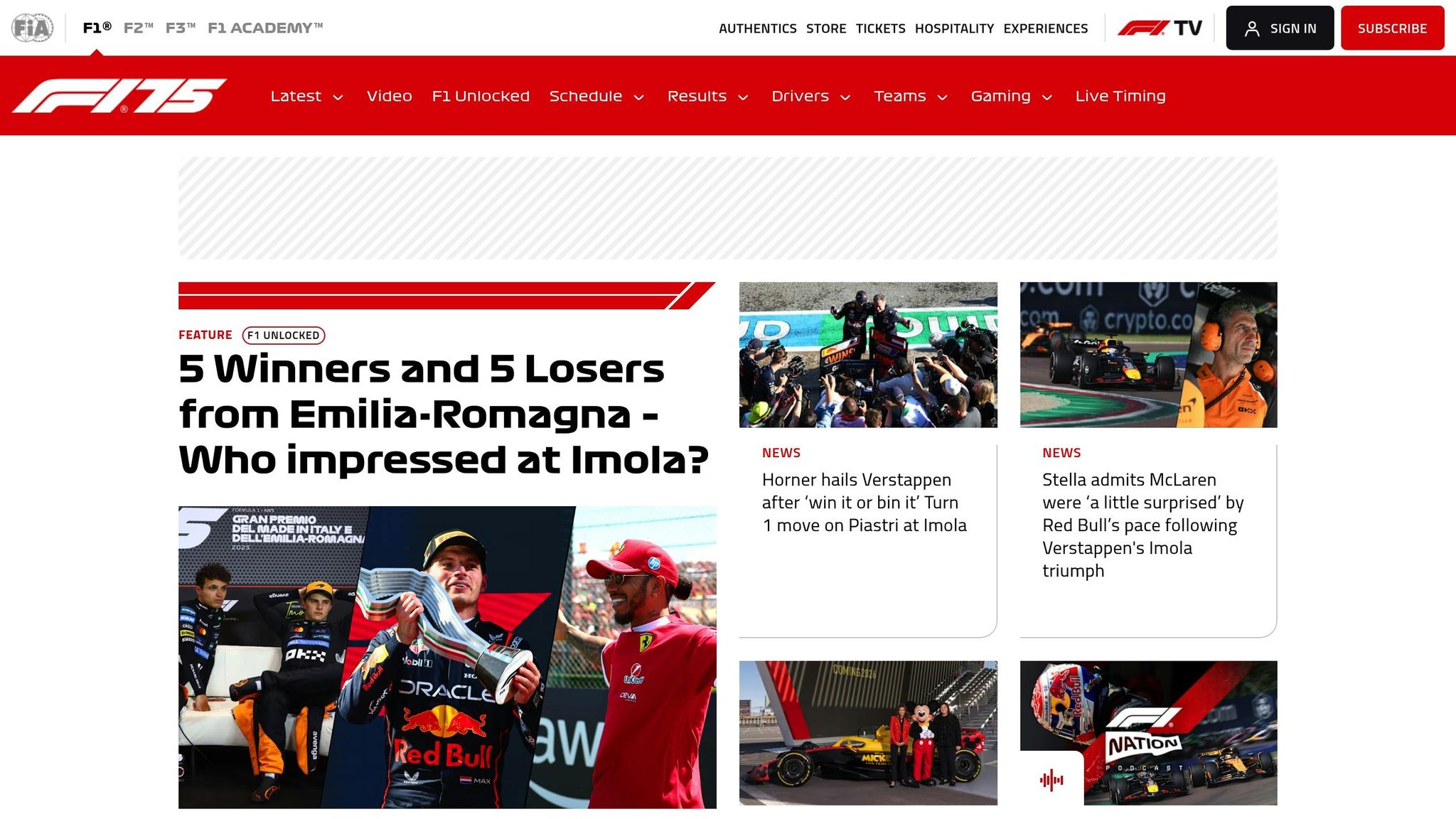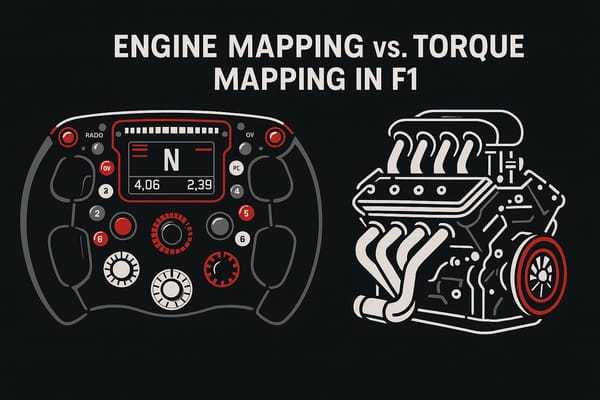How AI Deciphers F1 Radio Strategies
Explore how AI transforms Formula 1 strategies through real-time analysis of team radio communications and data integration.

AI is revolutionizing Formula 1 race strategies by analyzing team radio communications in real time. Here's how it works:
- Real-Time Transcription: AI-powered Speech-to-Text systems transcribe radio messages instantly, even decoding complex F1-specific jargon like "Li-co" (lift and coast) or "Box opposite Gasly" (pit strategy).
- Strategic Insights: Natural Language Processing (NLP) tools analyze the intent and urgency of messages, identifying critical communications with 75% accuracy and categorizing 93% of messages by importance.
- Data Integration: AI combines radio data with telemetry (1.1 million data points per second) to refine strategies during races, such as optimizing pit stops and tire management.
- Secured Communication: Advanced encryption ensures team strategies remain private, even as AI processes data in real time.
- Post-Race Learning: Teams like Ferrari use AI to evaluate driver feedback for technical accuracy, improving future performance.
AI systems have already demonstrated success, such as helping drivers secure podium finishes by optimizing race tactics. With teams processing billions of data points weekly, AI is reshaping decision-making in Formula 1.
| Key AI Features | What It Does |
|---|---|
| Speech-to-Text Processing | Converts radio audio into text instantly |
| NLP for Message Analysis | Detects urgency, emotions, and strategic intent |
| Data Integration | Merges telemetry with radio for better insights |
| Security Measures | Protects sensitive team communications |
AI isn't replacing human decision-making - it’s enhancing it by delivering actionable insights in as little as three seconds. This technology is set to further transform race strategies and elevate the fan experience with predictive analytics and interactive insights.
The Amazing Role Of Data, AI And Cloud In Formula 1

F1 Team Radio: Communication Challenges
F1 team radio communications are a whirlwind of technical jargon, rapid-fire exchanges, and secure transmissions - all of which make it a tough nut for AI to crack.
Secure Real-Time Messages
In the high-stakes world of F1, securing team communications is non-negotiable. Past breaches have highlighted just how crucial it is to keep strategic messages private. To achieve this, teams rely on advanced encryption techniques that not only safeguard their plans but also minimize processing delays, ensuring AI systems can keep up in real-time. But encryption is just one part of the puzzle - teams often use specialized code words that require AI systems to go a step further in understanding and interpreting the context.
Team Code Words and Tactics
Once the messages are secure, the next challenge is decoding the shorthand language teams use. These aren’t just random abbreviations; they’re packed with meaning that’s critical for race strategy. Here are a few examples:
| Term | Meaning | Context |
|---|---|---|
| Li-co | Lift and coast | A tactic for managing fuel |
| B-Bal | Brake balance | Adjusting car handling |
| Deg | Degradation | Monitoring tire wear |
But it doesn’t stop at abbreviations. Instructions like "Box opposite Gasly" carry nuanced tactical strategies, such as directing a driver to pit in contrast to a specific competitor's move.
During the heat of a race, these communications become even more complex. They’re often less precise and heavily influenced by the emotions of the moment. Studies of similar high-pressure environments show word error rates can range from 4% to 17%. This adds another layer of difficulty, especially since selected radio clips are broadcast live to fans, competitors, and FIA officials during race weekends. For AI systems, mastering this intricate web of communication is key to supporting split-second decisions that can make or break a race.
AI Tools for Radio Message Analysis
The task of securing and decoding real-time communications has always been a challenge in Formula 1. Now, AI tools are stepping in to transform audio and contextual cues into actionable insights that teams can rely on during races.
Audio-to-Text Processing
Formula 1 teams utilize Speech-to-Text AI to transcribe radio messages into text in real time. This involves capturing audio, extracting features, applying acoustic and language models, and finally decoding the information. During the 2021 Formula 1 season, custom vocabularies and advanced post-processing techniques significantly improved transcription accuracy:
| Language | Name Recognition Improvement | Overall Error Rate Reduction |
|---|---|---|
| English | 129.68% | 39.99% |
| Spanish | 110.62% | 37.16% |
| French | 136.15% | 55.08% |
This precise transcription not only ensures clarity but also sets the stage for deeper analysis using Natural Language Processing (NLP).
Message Purpose Detection
Once transcribed, NLP algorithms take over to analyze the messages for their strategic intent and emotional undertones. These machine learning models are trained to detect critical elements like urgent calls, driver emotions, potential safety risks, and technical feedback. The system operates under immense pressure, parsing specialized Formula 1 terminology while processing vast amounts of real-time data.
By combining these insights with telemetry data, teams can turn raw communication into actionable strategies, enhancing their decision-making during races.
Data Combination and Analysis
Integrating radio communications with sensor data has solved many earlier challenges, offering a more nuanced understanding of race dynamics. Each Formula 1 car generates around 4TB of sensor data during a single race. By merging this telemetry with radio data, AI systems provide a complete view of the race. A great example comes from the 2024 Hungarian Grand Prix, where Max Verstappen raised concerns about his team’s strategy. AI tools cross-referenced his feedback with live tire wear data, track positioning, and competitor patterns to help refine decisions.
This integration involves synchronizing radio timestamps with sensor data and identifying patterns between communication styles and race outcomes. With the ability to process up to 10,000 data points per second for each car, these systems enable teams to make informed, real-time decisions based on a combination of hard metrics and qualitative insights from radio communications.
Using AI Insights for Race Decisions
Formula 1 teams rely on real-time data to make lightning-fast strategic decisions that can shape the outcome of a race. Building on earlier methods of data integration, these teams now use AI-driven insights with incredible accuracy during live events.
Live Race Adjustments
During each race, McLaren Racing processes over a terabyte of data, including real-time speech-to-text and sentiment analysis of competitors' radio communications.
"According to Edward Green, Head of Commercial Technology at McLaren Racing, AI augments decision-making, processing data in as little as three seconds."
A great example of this was the 2022 Dutch Grand Prix. BWT Alpine F1 Team’s AI system transcribed McLaren's radio communication about safety car windows. Acting on this information, Alpine made an early pit stop, gaining a strategic edge.
The impact of AI on race strategy is evident in the following metrics:
| Strategy Component | AI Processing Capability | Impact on Decision-Making |
|---|---|---|
| Radio Analysis | 50 billion data points/week | Real-time insights into competitors' moves |
| Car Telemetry | 1.1 million data points/second | Immediate adjustments to performance |
| Strategy Simulation | 300 million pre-race simulations | Optimal pit stop and tire strategies |
While these tools shine during races, they also play a critical role in refining strategies after the checkered flag.
Race Review and Learning
AI doesn’t just help in the heat of the moment - it’s also invaluable for post-race analysis. Teams use it to sift through massive amounts of data, identifying patterns and areas for improvement. For example, Ferrari employs natural language processing to evaluate radio communications, rewarding drivers who achieve over 85% technical accuracy in their feedback.
"Data is probably most of our world now."
– Matthieu Dubois, chief strategist for BWT Alpine F1 Team
The benefits extend to engineering efficiency as well:
- Response times have dropped from over 24 hours to less than 20 minutes
- Resolution times have been cut by up to 86%
- Engineer queries are now resolved in just 5–10 seconds
McLaren’s challenges at the 2024 Silverstone Grand Prix underscore the importance of AI in decision-making. The team struggled with pit stop timing and tire choices - areas where AI-driven predictive analytics could have provided more reliable guidance.
Technical Limits and Ethics
AI analysis of F1 radio communications offers strategic insights, but teams face significant technical challenges and ethical considerations.
Data Processing Speed Limits
The roar of engines, pit lane commotion, and other background noise often interfere with transcription accuracy. Current automatic speech recognition (ASR) systems struggle under these race-day conditions, where the complexity of F1-specific terminology adds another layer of difficulty. Teams rely on unique jargon, coded language, and even multilingual exchanges, which can confuse standard natural language processing tools. Yet, decisions must be made in real time, leaving no room for delays.
| Processing Challenge | Impact on Analysis | Solution |
|---|---|---|
| Background Noise | Reduces accuracy during high-speed action | Advanced noise filtering algorithms |
| Technical Jargon | Misinterprets specialized terms | Custom F1 language models |
| Multi-language Support | Slows down international team analysis | Real-time translation engines |
| Processing Speed | Causes delays in strategic decisions | Edge computing deployment |
These obstacles push teams to innovate for faster, more reliable processing while ensuring that their communications remain secure and accurate.
Data Security and Privacy
Beyond technical hurdles, the secure handling of sensitive data is a top priority. The risks associated with AI-powered radio analysis are high, as evidenced by F1's history. The infamous 2007 Spygate scandal, where McLaren was fined $100 million after being caught with Ferrari's technical data, highlighted the devastating consequences of compromised information.
Other incidents, like Williams F1 canceling its AR car launch in 2021 due to data leaks, Ferrari's ransomware attack in 2022, and NASCAR losing track data, further emphasize how vulnerable teams can be.
To counter these risks, F1 teams have adopted stringent cybersecurity measures, including:
- Zero Trust Architecture: Ensures all system access requires authentication.
- Multi-Factor Authentication (MFA): Secures critical systems with additional verification steps.
- End-to-End Encryption: Protects remote engineer communications.
- Next-Generation Firewalls: Monitors and analyzes traffic in real time.
Maintaining this balance between staying competitive and safeguarding sensitive data is an ongoing challenge. Teams must constantly refine their security measures while ensuring their systems can process and analyze data quickly enough to support split-second race strategies.
Conclusion: Next Steps for AI in F1 Radio Analysis
AI is transforming the way Formula 1 teams approach race strategy, blending real-time insights with secure communication to make lightning-fast, data-driven decisions. Edward Green, McLaren Racing's Head of Commercial Technology, highlights this balance:
"We have our belief about human-in-the-loop. AI is not there to replace anybody. AI is there to add to our data scientists and engineers and helps inform their decisions. In Formula 1, those decisions can come really fast. Sometimes they can be as short as three seconds and that's a really small amount of time to look and ingest data to make the right call and inform the entire team of that decision."
This ability to act quickly is further supported by cutting-edge partnerships. For example, AWS has significantly reduced aerodynamic simulation times - from four days to just eight hours - since 2018, giving teams a critical edge during races.
Looking to the future, several areas stand out as opportunities for further innovation in race-day strategies:
| Area | Current Status | Future Development |
|---|---|---|
| Real-time Analysis | Basic transcription and filtering | Predictive strategic analysis |
| Fan Engagement | Standard broadcast insights | Interactive simulations and personalized insights |
| Security | Traditional encryption | Advanced encryption and real-time anomaly detection |
AWS's StatBot is another tool reshaping the sport, enhancing both team performance and fan experiences. Neil Ralph from AWS explains:
"With AWS' generative AI capabilities, F1 will elevate its storytelling as historic data is effortlessly analysed alongside real-time events to engage fans with more dynamic and timely commentary. Together, we are redefining the way the sport is watched, raced and managed."
The numbers back this technological shift. By 2024, the global AI in sports market is expected to reach $5.93 billion, with an annual growth rate of around 30%. Pete Samara, Director of Technology and Digital Innovation, underscores the importance of data in shaping the F1 narrative:
"There's so many stories that are within Formula One and I think the AWS insights from the last five and six years tell that narrative in a simple way. Leaning on your partner is very important for this. We are a storytelling machine, excitement and suspense is what we have to build, and the data is at the heart of that."
Through these advancements, AI will continue to sharpen race strategies and enrich fan experiences, ensuring Formula 1 stays at the cutting edge of motorsport innovation.
FAQs
How does AI understand the unique language used in F1 team radio communications?
AI taps into the power of natural language processing (NLP) to make sense of the highly specialized language used in Formula One team radio exchanges. This involves breaking down the sport's unique jargon, abbreviations, and code words - terms that can often be cryptic and highly technical. By analyzing extensive datasets of past radio communications and related contextual information, AI systems can uncover the patterns and meanings behind these phrases.
What’s more, AI keeps up with the ever-changing nature of F1 communication. As teams introduce new strategies and update their terminology, these systems continuously refine their understanding. This ensures they stay sharp when interpreting and analyzing race-day conversations. The result? Teams can pull out actionable insights and make smarter, faster decisions during the heat of competition.
How do Formula One teams protect their strategies when AI analyzes live radio communications?
In Formula One, teams go to great lengths to keep their strategies under wraps when AI systems process live radio communications. They rely on advanced encryption protocols to ensure that any sensitive information transmitted during a race remains secure and out of reach from prying eyes. On top of that, strong cybersecurity measures are in place to guard against potential cyberattacks.
To stay ahead of threats, teams continuously monitor their communication networks. AI plays a key role here, analyzing data traffic in real time to spot anything unusual. If an anomaly is detected, teams can act quickly to neutralize risks and protect their strategic plans. These precautions are essential in the fiercely competitive and high-pressure environment of Formula One.
How does AI help F1 teams make better decisions without replacing human strategists?
AI plays a pivotal role in Formula One by processing massive amounts of real-time data - like telemetry, track conditions, and weather updates - to deliver actionable insights during races. By spotting patterns and proposing optimal strategies, it helps teams adapt swiftly to ever-changing scenarios on the track.
That said, AI doesn’t take over for human strategists. Instead, it works alongside them, providing data-driven suggestions that enhance decision-making. The human experts still interpret these insights, factoring in the subtleties of race dynamics, team objectives, and driver preferences. This teamwork strikes a balance, blending the precision of technology with the instinct and experience of human judgment.




